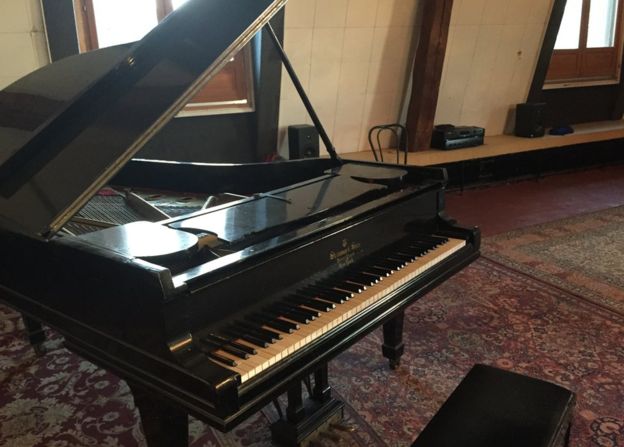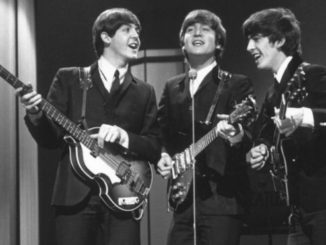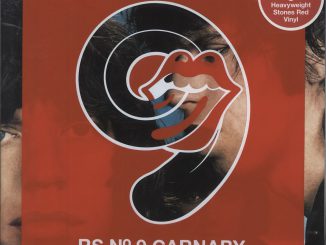A once-famous recording studio in a French chateau is being refurbished and will reopen in 2016. Hugh Schofield had an exclusive tour of the Chateau d’Herouville – where the original piano used by Elton John on Goodbye Yellow Brick Road has languished for more than 30 years in an attic.
Once upon a time there was a Honky Chateau.
That was the name that Elton John gave to one of his favourite studios – the Chateau d’Herouville.
In 1972 and 1973 three of his best-loved early albums were recorded in the loft of the 18th Century pile: Honky Chateau, Don’t Shoot Me I’m Only the Piano Player, and Goodbye Yellow Brick Road.
Sir Elton (as he wasn’t back then) was one of many British and American rock acts who came to Herouville in the early 70s – earning it the nickname of “France’s Abbey Road”.
Except Herouville was much more than Abbey Road.
Not only could it offer top-class recording facilities, just an hour outside Paris, what attracted the likes of David Bowie, T Rex, Cat Stevens, Pink Floyd – and later the Bee Gees, Richie Blackmore, Iggy Pop, etc etc – was also a lifestyle.

“Herouville was the original residential studio. It was a kind of hotel. The musicians didn’t just make music. They could sleep, eat, live here. If they wanted to record in the middle of the night, that was fine,” says Eric Baert, who is mayor of the 600-strong village of Herouville.
“And the story goes that Michel Magne was pretty good at hospitality!”
Michel Magne is the central figure in the story of the Honky Chateau.
He was the composer and musician – well-known in France after writing scores for several hit films – who bought the chateau in 1962.
Set in the middle of the village, the chateau has two wings which once ran together but are now joined only by a wall. There is a large garden, and outbuildings set around an octagonal (and officially protected) stone drinking trough.
In the mid-19th Century, Chopin is said to have conducted his love affair with the writer George Sand here. That is why Magne named his main recording area – up in the eaves – the George-Sand.

At the end of the 1960s, Magne had the idea of creating a new kind of studio – one where musicians would be freed from the rigid conservatism of the corporate system.
“People said I was mad because no-one would want to make the 30km (19 miles) journey from Paris to record in the middle of nowhere,” he said.
“But then they saw the groups arriving from America.”

Among the first to discover the charms of Herouville were the Grateful Dead.
In June 1971, they had been due to play at a free festival nearby, but it was rained off. As they were staying at the chateau, they instead decided to put on an impromptu concert in the gardens. Villagers provided the audience.
The concert was caught on film, showing the San Franciscans in peak form.
One of those watching (and dancing) was 17-year-old Marie-Claude Calvet. A Bardotesque schoolgirl, she had met Magne the year before while hitchhiking near Herouville. They were to marry in 1972.

“Those years were like a dream. It was magical to sit in the studio and watch these great artists like Elton John and Pink Floyd play. It was only many years later that I realised how lucky I had been,” she says.
The Dead concert stays in Marie-Claude’s mind as a highpoint.
Michel Magne was reluctant to use police as security, so the mayor agreed to lend the local fire brigade. Unbeknownst to the firefighters, the wine they drank had been lightly laced with LSD.
Many of them were later seen cavorting naked in the swimming pool.

“The next day we got up. The Grateful Dead had gone, but before they went they had cleaned up the entire garden. They were such nice guys,” she says.
Marc Bolan recorded The Slider and Tanx. Pink Floyd recorded Obscured by Clouds. Cat Stevens came for Catch Bull at Four. Uriah Heep did Sweet Freedom. David Bowie recorded Pin Ups and later – in 1977 – Low.
By that time though the heyday was over. Running the chateau was costing a fortune, and Magne was a hopeless manager. The carefree atmosphere of the early 70s was doomed. In 1974 Magne and Marie-Claude moved to the south of France, leaving the studios to be run by new hands.
For a few years they kept going. The Bee Gees came for Saturday Night Fever – recording much of the vocals in the stairwell because of its great acoustics – and later there were Sham 69 and Fleetwood Mac.
But Herouville continued to haemorrhage money. Pursued by creditors, Michel Magne became obsessed by the idea of returning to his beloved chateau. It was hopeless: the law was moving in. In 1984, he killed himself in a hotel room a few miles from his erstwhile home.
The chateau was abandoned. A developer planned to turn it into flats, but happily was blocked (the protected drinking trough was the saviour). The garden turned to jungle.

Periodically music fans would peer through the iron railings, trying to summon up the spirit of what was now a decaying ruin.
But today – more than 30 years on – the chateau is beginning to breathe again.
Four French friends with long experience in the music business have found the money to buy the chateau and start restoring the studios to their former glory. A first studio has been opened in the outbuildings, where they run training sessions for sound engineers, and the next stage will be the famous George-Sand.
Jean Taxis, Thierry Goracino, Pascal Besnard and Stephane Marchi know that the task ahead is a long and expensive one.
“We have been friends for 30 years, and for 30 years we have had a dream of building a place where expertise and creativity can be seamlessly associated,” says Marchi, who works in media finance in London.
“Ultimately we want to expand from sound recording to other mediums – writing, sculpting, painting. In everything we are inspired by the idea of recreating the state of mind that prevailed here in the early 70s.”
How would he define that state of mind? “Freedom.”
Today the gardens have been cleared so you can see the pool where once LSD-happy firemen dive-bombed with local lovelies. There is a gnarled tree which as a sapling was given to Michel Magne by a visiting Jane Fonda (fresh from Barbarella).
Inside the chateau, signs of life are returning. Jean Taxis lives with his wife on the first floor of one of the wings.
Up the Bee Gees staircase, we arrive beneath the eaves in the historic George-Sand studio.
There are old acoustic tiles on the walls, and what look like mattresses hammered into the ceiling. But the sound is pure, and a specialist has said it needs little work to be back in business.
In the corner stands a grand piano, a Steinway.
For more than half a century it has stood in this place, because it was Magne’s personal piano.
Wonderful to relate, these are the very keys on which – more than 42 years ago – Elton John embarked on the opening bars of Goodbye Yellow Brick Road.

Via the BBC





Be the first to comment